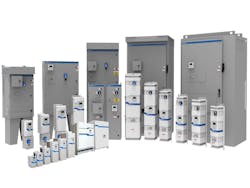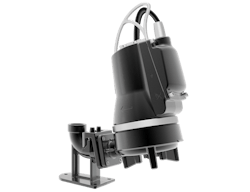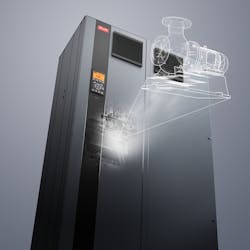About the author:
Ray Scroggins is a freelance writer for Water & Wastes Digest. Scroggins can be reached at [email protected].
Although the pandemic shut down a lot of things, technological developments continued to move forward in 2021. What follows is an overview of a few areas critical to the water and wastewater fields where progress has continued mostly unabated.
Digital Twinning
With a digital model (twin) of a system, process or plant, it is possible to compare the results of real-time simulations with actual data from sensors to identify operating anomalies and evaluate solutions without disrupting operations.
According to water technology provider Xylem Inc., these simulations may use one or many hydraulic and/or hydrological models, process models or water quality models, often hosted in the cloud. Benefits of applying digital twins include potentially dramatic savings in capital and operating expenses, much better real-time performance with the ability to respond more quickly to sudden weather events, and environmental sustainability, with better protection and outcomes.
Digital twin/RT-DSS (real-time decision support system) applications include:
- Optimizing processes to minimize chemical and energy inputs at treatment plants while also stabilizing processes and minimizing oscillation.
- Optimizing drinking water networks to minimize energy consumption while ensuring safe and equitable water quality.
- Optimizing wastewater networks to minimize or eliminate overflows, street flooding and basement back-ups.
Smart Pumps
Smart pumps save energy and provide customer benefits that include reduced pipe system noise, constant pressure at the water tap and constant water temperature throughout the year.
Pump manufacturer Grundfos was the first company to build variable speed drives into its pumps for clean water applications, and its smart pumps now incorporate greater energy optimization, advanced condition monitoring and connectivity so they function more effectively as part of a larger system. Its wastewater pumps incorporate built-in sensors and intelligence for autonomous operation.
With greater connectivity, smart pumps integrate easily into water and wastewater systems. Water pressure can be adjusted continuously throughout the distribution network, reducing energy usage and non-revenue water leakage. Grundfos said that smart pumps will deliver even more energy efficiency and condition monitoring to maximize system capacity while minimizing maintenance.
Smart Drives
Smart drives gather a large volume of information, which they use to learn and then predict and react to conditions and avert unplanned outages or catastrophic failures. They also can make adjustments and perform much of their own maintenance, which saves time and reduces costs.
For example, Danfoss drives feature software with “Conditioned Based Monitoring” and edge computing inside the drive, to monitor multiple data points. These may include factors such as motor winding status, pump and motor vibration levels and complete “Load Envelope Status” in near-real time, without requiring a cloud-based subscription. This provides more performance data and greater operating efficiency. The company’s VLT AQUA Drive has a “de-ragging” feature that will detect and clear a clogged pump, reversing it if the pump design allows. Danfoss expects drives to offer continuingly increasing autonomy in system performance and to become more user friendly, easier to program and more efficient.
Eaton’s drives incorporate sensors and sensing technologies that embrace the internet of things (IoT) to monitor and control systems remotely. By collecting and transforming data into actionable insights, this improves efficiency, reduces costs and maximizes uptime.
The company uses digital models (“digital twins”) to mimic physical assets so solutions can be designed, built and tested virtually without large capital investments. In a multi-pump system configured for staging and de-staging, IoT-enabled VFDs help monitor the system’s health, change set points as required and even change their starting and stopping schedule.
Compressors & The Cloud
Compressed air helps drive wastewater treatment processes that remove or reduce harmful particles such as suspended solids, biodegradable organics, pathogenic bacteria and nutrients.
Atlas Copco, a compressor and blower manufacturer, says plant-wide SCADA systems have become the industry norm, with increasing adoption of remote monitoring technologies such as IoT and cloud-based systems to track equipment usage and power consumption over time. This data can be used to schedule preventive maintenance, plan for the end of equipment life and identify potential energy saving measures. Atlas Copco blowers and compressors include integrated controls with automatic restart after voltage failure.
This ensures that as soon as the backup power supply starts, the blowers and compressors will restart and return to their programmed set-points without any operator interaction. In addition, products are available that utilize bearings with electro-magnetic levitation, which supports moving parts without physical contact and eliminates lubricating oil. They also utilize residual capacitance in the electrical circuit to power the bearings in the event of a shutdown, eliminating the need for a UPS. This ensures that the equipment slows to a stop safely while the shaft is still levitated.
Smart Hydrants
Smart hydrants can gather pressure and transient monitoring data in near-real time and detect leaks in buried mains from above the surface.
One example from Mueller Water Products is new software in the company’s Super Centurion hydrants that is also retrofittable to its Centurion hydrants from 1975 on. For utilities, the biggest benefit is the ease and affordability of adding leak detection and pressure monitoring to existing infrastructure, without the need to dig. The hydrant effectively becomes a communications hub, sending data via a cellular network to the Sentryx Water Intelligence Platform, where operators can gain insight easily into the health of their water distribution system.
The company notes that the added technology does not compromise a hydrant’s ability to deliver the high volumes of water needed for fire-fighting. Future smart hydrants are expected to collect even more data from numerous sensors throughout a utility’s system. Advances in IoT devices, machine learning and artificial intelligence will give utilities the ability to identify new types of network anomalies much more quickly.
Power Generators
Generators supply standby power to run critical plant systems during a power failure.
All of Generac Industrial Power’s natural gas systems are Smart Grid Ready, so owners can also offset their energy costs by selling power back to the grid in times of high-cost peak demand. Generac’s controllers emphasize remote connectivity, with Wi-Fi and Bluetooth capabilities, the ability to interface with Modbus, ethernet and SNMP protocols, as well HDMI. Another development is the use of variable frequency drives and soft starters, which can reduce the motor inrush current load and allow the use of smaller generators.
Doosan generators can be paralleled to operate in unison during peak demand and drop off-line during low demand hours or for planned maintenance. In combination with an oversized alternator, this provides higher motor starting capability for pumping applications. Remote monitoring and remote control continue to become more important, often eliminating the need for a service technician’s visit. Doosan also notes that engine manufacturers have significantly improved hardware and software for generator applications, which greatly reduces minimum load requirements and wet stacking.
Packaged Systems
With a system or an entire plant designed by a single manufacturer or supplier, responsibility is centralized. This can speed up maintenance and repairs, reduce downtime


